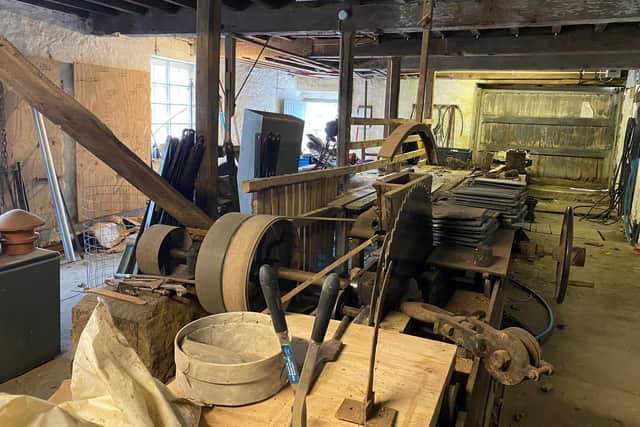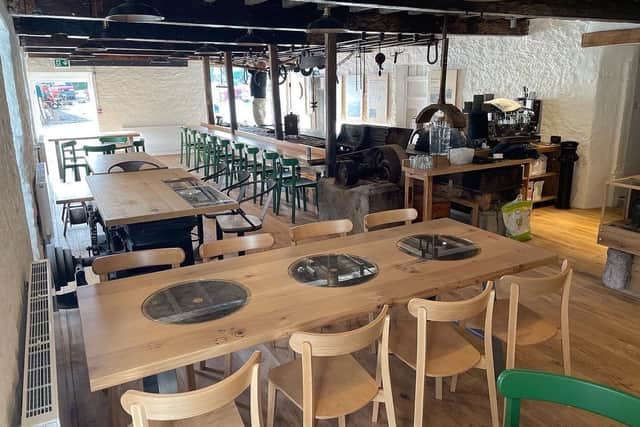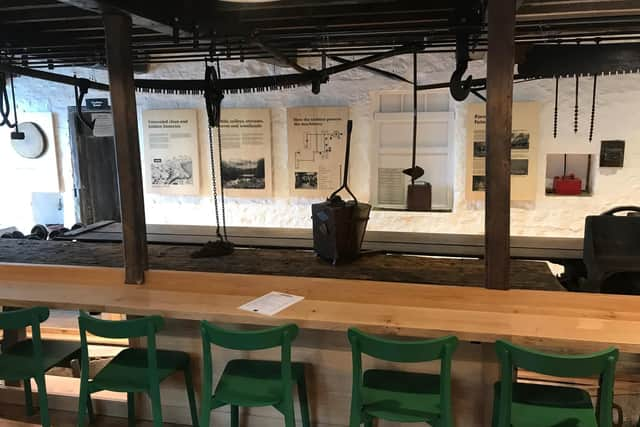Ingleborough Cave owners open first cafe after converting Grade II-listed Dales sawmill
The Old Sawmill at the entrance to the nature trail is a Grade II-listed building and its heritage has been incorporated into the design - with the original saw and bench on display and old blades set into tables. All of the old tools and equipment were salvaged from the sawmill, which was a joinery workshop and storage shed before the renovation.
Ingleborough Cave and Nature Trail managing director Andrew Jarman began planning the conversion project three years ago, and work started last autumn.
Advertisement
Hide AdAdvertisement
Hide AdIt is the first time the attraction, which is over a mile from the nearest road, has had a cafe, as there is no running water at the shop near the cave entrance.


The sawmill is marked on a tithe map in 1851, during a period in which the milling of corn and cotton - powered by waterwheels - was a significant local industry in Clapham.
By 1896, an Ordnance Survey map shows the present building had been extended. There is also a drying shed and Sawmill Cottage - then a kiln - marked.
Into the 20th century the sawmill remained a vital part of the Ingleborough Estate's forestry operation. Until the 1960s, this was mostly done manually, with timber hauled off the hillsides by horse and cart until chainsaws were introduced in the 1960s.
Advertisement
Hide AdAdvertisement
Hide AdThe building gradually fell out of use as a sawmill, but was retained by the estate as a joinery workshop until 2020, with much of the old equipment remaining in place.


Ingleborough Cave - a series of caverns famous for their stalagmite and stalagtite formations - was discovered in 1837, and has been run by the same family for 65 years.
Bob Jarman, a former head of technology at Lancaster University, decided to start showing visitors around the cave system in the 1950s with two friends and a wooden hut for support. His wife Sue came on board and they opened a shop and installed electric lighting before their son Andrew joined them. Now in his 80s, Bob still helps out with the maintenance today.
Since the Jarmans took over the lease on the caverns from the Ingleborough Estate, they've witnessed some memorable moments, including the opening of the hitherto-mythical underground link to Gaping Gill by divers in 1983, the discovery of a prehistoric woolly rhinoceros tooth by a sixth former working part-time in the caves in 2001, and an epic flood which washed away a walkway in 2015.
Advertisement
Hide AdAdvertisement
Hide AdIt was first opened to visitors in 1837 by local landowner James Farrer. The features beyond the entrance were hidden behind large calcite dams, and water had submerged the passages.


After a severe flood, Farrer realised that there must be an outflow of water beyound the dams. He broke down the calcium deposits, released the trapped water and exposed a hidden wonderland of formations and fossils.
By the late 1950s, Bob Jarman and his friends were taking time off from their day jobs to show visitors around by the light of Tilley oil lamps, but they realised the spectacular caverns had so much more potential.
"At first they just had a wooden shed and the Tilley lamps, but they gradually put in paths and handrails to make it easier for visitors. Eventually my dad did the wiring for the lighting - he'd worked at Rolls-Royce before," explained Andrew.
Advertisement
Hide AdAdvertisement
Hide AdMotivating them was the long-held belief by locals and potholers that Ingleborough Cave was the outflow of the stream that feeds Gaping Gill, the vast, 100-metre chasm - if only divers could find the passage that connected them.
They have developed the attraction to the extent that it is now acknowledged as the best show cave in the UK - by no less than a trade association of other show caves around the country.
"We're on a popular route for walkers, so we get the Three Peaks traffic from Ingleborough. We did a bit of advertising and we grew through word of mouth as well. We built the shop, extended it, added more refreshments and toilets, a picnic area, and we want to add in a new building next to improve the facilities."
Hundreds of children visit the caves every day as part of school trips, and, poignantly, so do a large number of pupils from Bradford, who stay at the Ingleborough Hall outdoor centre. Many of them have never been into the countryside before, but, according to Andrew, are 'gripped' by the subterranean world.
Advertisement
Hide AdAdvertisement
Hide AdDespite harsh Dales winters, the cave's staff - among them a one-legged guide called Chester - open it up daily between February and October, and at weekends at other times. Their Santa's grotto events (Bob himself has been Santa in his younger years) attract over 1,000 people a day and Christmas has become their busiest time of year.
The mythology of the cave system has certainly captured the imagination of Andrew, who followed in his parents' footsteps and also runs the neighbouring nature trail.
"I remember when the rhino tooth was found in 2001 - a 16-year-old girl who worked part-time here was helping Bradford Pothole Club with a dig. She picked up a handful of dirt and spotted something with a peculiar texture. We took it to a museum and they tested it and told us it was from a woolly rhinoceros, which are long-extinct. It's in a museum now."
While the discovery of the link to Gaping Gill was the Holy Grail for the local caving community.
Advertisement
Hide AdAdvertisement
Hide Ad"It was always thought that the system linked up to Gaping Gill, and in 1983 the divers discovered it after 15 hours of rough caving, most of it underwater. They did the trip five or six times after that, but then there was a boulder collapse and it's not accessible any more."
While Storm Desmond over Christmas 2015 saw the caves flood catastrophically at the same time as water tumbled over Malham Cove for the first time in living memory.
"It flooded right up to the steel door. It was locked, as we'd decided earlier in the day to close when we saw the forecast. It blew the concrete path clean off - it lifted it up. We are very wary about flooding and would never open if there was a risk," added Andrew.
Comment Guidelines
National World encourages reader discussion on our stories. User feedback, insights and back-and-forth exchanges add a rich layer of context to reporting. Please review our Community Guidelines before commenting.

